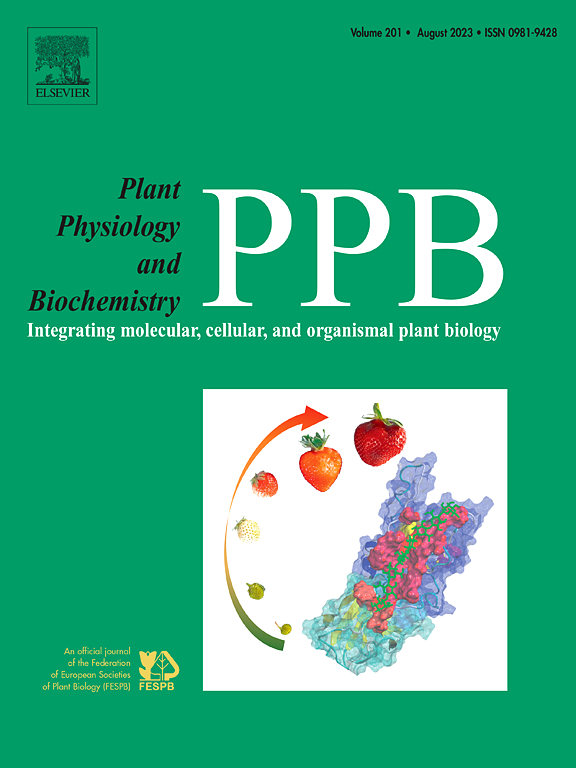Maize ZmEREB130 transcription factor negatively regulates growth and seed size
IF 6.1
2区 生物学
Q1 PLANT SCIENCES
引用次数: 0
Abstract
The APETALA2/Ethylene Response Element Binding Protein (AP2/EREBP) is a kind of plant-specific transcription factor and plays a pivotal role in governing plant growth, ontogenesis, and stress acclimation processes. However, the AP2 members modulating plant height and seed morphogenesis remain largely unelucidated. In the present study, the maize ZmEREB130 gene was cloned and functionally validated in modulating growth and seed size development. Our findings demonstrated that ZmEREB130 protein harbors two conserved AP2 domains, localized to the nucleus, exhibits no self-activation activity, and is a canonical AP2 transcription factor. The results of Y2H, BiFC, and split-LUC assays revealed that ZmEREB130 undergoes homodimerization via its AP2 domain, and interacts with ZmFdx1/5. The ZmEREB130 exhibited predominant expression in maize seeds. Heterologous expression of ZmEREB130 in Arabidopsis resulted in the suppression of plant growth and reduction of seed dimensions. Phenotypic analyses demonstrated that five transgenic lines manifested reduced seedling size, diminished biomass accumulation, delayed flowering, decreased plant height, and significantly reductions in seed length, width, and weight compared to wild type plants. The results of RNA-seq, qRT-PCR, and dual-LUC assays implied that ZmEREB130 binds to the promoters of development-associated genes, modulating their transcription and ultimately impeding growth and ontogenesis of transgenic Arabidopsis. This study provides evidence that ZmEREB130 functions as a negative regulator of plant growth and development, thereby presenting a novel candidate gene for maize genetic improvements aiming to achieve high-yield traits via genome-editing technologies.
ZmEREB130转录因子负调控玉米生长和种子大小
aptala2 /乙烯响应元件结合蛋白(AP2/EREBP)是一类植物特异性转录因子,在调控植物生长、个体发生和胁迫适应过程中起关键作用。然而,调控植株高度和种子形态发生的AP2成员在很大程度上仍未被阐明。本研究克隆了玉米ZmEREB130基因,并对其在调节生长和种子大小发育中的功能进行了验证。我们的研究结果表明,ZmEREB130蛋白含有两个保守的AP2结构域,定位于细胞核,不具有自激活活性,是一个典型的AP2转录因子。Y2H、BiFC和split-LUC分析结果显示,ZmEREB130通过AP2结构域进行同二聚化,并与ZmFdx1/5相互作用。ZmEREB130在玉米种子中表现出优势表达。ZmEREB130在拟南芥中的异源表达导致植株生长受到抑制,种子尺寸减小。表型分析表明,与野生型植物相比,5个转基因株系表现出幼苗大小减小、生物量积累减少、开花延迟、株高降低、种子长度、宽度和重量显著降低的现象。RNA-seq、qRT-PCR和双luc分析结果表明,ZmEREB130与发育相关基因的启动子结合,调节其转录,最终阻碍转基因拟南芥的生长和个体发生。本研究提供了ZmEREB130作为植物生长发育负调控因子的证据,从而为玉米遗传改良提供了一个新的候选基因,旨在通过基因组编辑技术实现高产性状。
本文章由计算机程序翻译,如有差异,请以英文原文为准。
求助全文
约1分钟内获得全文
求助全文
来源期刊
CiteScore
11.10
自引率
3.10%
发文量
410
审稿时长
33 days
期刊介绍:
Plant Physiology and Biochemistry publishes original theoretical, experimental and technical contributions in the various fields of plant physiology (biochemistry, physiology, structure, genetics, plant-microbe interactions, etc.) at diverse levels of integration (molecular, subcellular, cellular, organ, whole plant, environmental). Opinions expressed in the journal are the sole responsibility of the authors and publication does not imply the editors'' agreement.
Manuscripts describing molecular-genetic and/or gene expression data that are not integrated with biochemical analysis and/or actual measurements of plant physiological processes are not suitable for PPB. Also "Omics" studies (transcriptomics, proteomics, metabolomics, etc.) reporting descriptive analysis without an element of functional validation assays, will not be considered. Similarly, applied agronomic or phytochemical studies that generate no new, fundamental insights in plant physiological and/or biochemical processes are not suitable for publication in PPB.
Plant Physiology and Biochemistry publishes several types of articles: Reviews, Papers and Short Papers. Articles for Reviews are either invited by the editor or proposed by the authors for the editor''s prior agreement. Reviews should not exceed 40 typewritten pages and Short Papers no more than approximately 8 typewritten pages. The fundamental character of Plant Physiology and Biochemistry remains that of a journal for original results.

 求助内容:
求助内容: 应助结果提醒方式:
应助结果提醒方式:


